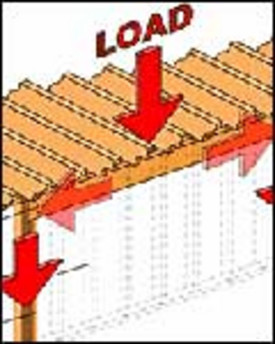Today’s typical floor plan often includes bright and open spaces with high ceilings. Before the advent of today’s modern building materials, these wide-open spaces were difficult—and often expensive—to achieve. As a result, remodeling plans for older homes may include punching holes in walls, creating pass-throughs, or removing walls entirely. With a little planning, these modifications can usually be achieved—even in load bearing walls.
Load Bearing Walls
The walls of the lower stories hold up the roof and upper levels of a house. These load bearing walls carry the weight of the floors above down through the home and into the foundation. To safely support the entire house, these walls must be carefully located beneath upper level floor joists. The upper level’s floor joist’s span capacity, which is a measure of the distance the floor joists can run without additional support form below, determines where bearing walls must be located. Conventional framing with dimensional (2x) lumber is adequate for most standard room sizes up to 16 feet wide from wall to wall. But, there are a growing number of framing options for longer or stiffer span requirements including engineered lumber, truss-joists, micro-lams, glulams, LVL’s, heavy timbers, and bar joists. These components make the great open spaces of contemporary design possible and are excellent options for renovations.
Remodeling Considerations
Bearing walls hold up your home, so when considering the removal of a wall, it is important to understand its role in the house. Some bearing walls are obvious because of their placement or appearance, others are not. Have an experienced builder or architect evaluate the situation before removing or altering any interior wall. Inadvertent removal of bearing walls can cause cracking of finishes, sagging floors, warped door and window openings, or even the collapse of the home. Unless a copy of the home’s original floor plan is available, destructive testing, or the cutting of small holes in the ceiling, can be done to verify the existing framing plan. While this may seem messy, it is a small price to pay to avoid the possibility of more costly repairs.
 |
||
| Removing a section of a load bearing wall to create a pass-through requires adding a new beam and columns to support the floor above. |
||
Redirecting the Load
There are several possible options to consider when removing or altering a bearing wall. A typical wall consists of a top and bottom plate and multiple vertical weight-carrying studs. When removing such a wall, the same load from above must be carried down a new path to the supporting structure below. Generally, a beam must take the place of the removed top and bottom plates and studs. The most common solution is to add the carrying beam below the ceiling or roof joists above (illustration). While this beam can be used as a design feature, it may be undesirable or produce a headroom (height) problem.
A second solution is to enclose a new support beam within the ceiling space. Floor joists above the removed wall portion are temporarily supported and cut. A new support beam is inserted into the cut area, and the existing joists are secured to the sides of the new beam with joist hangers. With the bottom of the new support beam flush with the bottom of the existing floor joists, the end result is a new beam that is concealed within the ceiling.
No matter the method, the weight is then transferred to supports or columns at the ends of the new beam. Since the loads from above the new opening must now travel down only two columns, special attention must be paid to their construction and placement. The weight transferred to the floor by the new columns that was originally distributed along the length of an entire wall is now concentrated in two places. In some circumstances, the new columns will need to extend directly to the foundation. Again, have this redirected load analyzed by a qualified professional to ensure the structural integrity of your home.
Credit: Renovate Your World




























